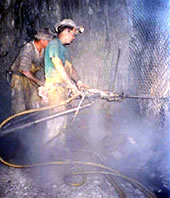
 |
|||
NIOSH Safety and Health Topic:Aerosols |
|
This page provides links to a variety of information regarding the measurement, control, exposure characterization and health effects associated with aerosols in the workplace. The definition of an aerosol, as used here, is a suspension of tiny particles or droplets in the air, such as dusts, mists, or fumes. These particles may be inhaled or absorbed by the skin, and can sometimes cause adverse heath effects for workers. NIOSH has carried out extensive research to minimize the adverse health effects associated with aerosol exposures. Results of such research are available through the links on this page. NIOSH Aerosol ResearchNIOSH Aerosol
Research Overview List of Active internal NIOSH research projects related to aerosols External NIOSH research projects related to aerosols may be found several ways:
Aerosol Research Gaps Aerosol Sampling
|
|||||||||||||||||||
Generation and Behavior of Airborne Particles (Aerosols)
![]() PDF
only 347 KB (40 pages)
PDF
only 347 KB (40 pages)
PowerPoint presentation providing an introductory overview of aerosol mechanics.
Disclaimer: The following links in this section go to web sites outside of CDC/NIOSH and should not be considered as an official endorsement of their content, or as a statement of NIOSH policy.
Aerosol
Science & Engineering |
||
 Optical Particle Counter http://aerosol.ees.ufl.edu/ opc/section01.html |
 Respiratory Deposition http://aerosol.ees.ufl.edu/ respiratory/section01.html |
 Learning About Cyclones http://aerosol.ees.ufl.edu/cyclone/ section01.html |
Aerosol Dictionary
Provides a variety of information on aerosol instrumentation, terminology,
more...
External link: http://www.aerosolsonline.com
Aerosol
Short Course
Brochure describing the annual 3-day seminar offered by the University of Minnesota.
External link: http://www.cce.umn.edu/conferences/aerosol/
Hazard Control
30: Control of Drywall Sanding Dust Exposures
DHHS (NIOSH) Publication No. 99–113
This document details several methods to control exposure to high
concentrations of dusts from sanding drywall joint compound.
Handbook
for Dust Control in Mines
DHHS (NIOSH) Publication No. 2003-147
Describes effective methods for the control of mineral dusts in mines.
NIOSH Manual of Analytical
Methods (NMAM)
DHHS (NIOSH) Publication No. 94-113 (1994)
NMAM is a collection of methods for sampling and analysis of contaminants in
workplace air, and in the blood and urine of workers who are occupationally exposed.
NIOSH Pocket Guide to Chemical
Hazards
DHHS (NIOSH) Publication No. 97-140
Exposure limits, Respirator Recommendations, First Aid, more...
The Pocket Guide is a source of general industrial hygiene information on several
hundred chemicals/classes found in the work environment. Key data provided for
each chemical/substance includes name (including synonyms/trade names), structure/formula,
CAS/RTECS Numbers, DOT ID, conversion factors, exposure limits, IDLH, chemical
and physical properties, measurement methods, personal protection, respirator
recommendations, symptoms, and first aid.
National
Occupational Research Agenda - Emerging Technologies
The NORA Emerging Technologies Team is working to establish mechanisms
to ensure that worker health and safety is considered when new technologies
are developed and implemented
Registry
of Toxic Effects
of Chemical Substances (RTECS)
RTECS
is a compendium of toxicological
information extracted
from the open scientific literature.
Disclaimer: The following links in this section go to web sites outside of CDC/NIOSH and should not be considered as an official endorsement of their content, or as a statement of NIOSH policy.
AAAR
Aerosol-related
links page.
External link: http://www.aaar.org/hplinks.htm
Aerosol Calculator
A
downloadable spreadsheet for calculating aerosol properties and behaviors.
External link: http://bgiusa.com/cau/downloads.htm
CIIT (Centers for Health Research)
A source for the multiple
path particle dosimetry model.
External link: http://www.ciit.org/techtransfer/tt_technologies.asp
ICRP
(International Commission on Radiological Protection)
A source for lung
deposition modeling software.
External link: http://www.icrp.org/index.asp
NRC
Report
Research priorities for particulate matter
External link: http://books.nap.edu/books/0309091993/html/index.html
National
Nanotechnology Initiative
A U.S. government initiative
to organize nanotechnology research, started in 2001
External link: http://www.nano.gov/
The Particle Atlas
A collection of electron micrographs of many
typical aerosol particles
External link: http://www.microdataware.com/pae2info.htm
Particulate
Matter Research Activities
This website is being developed to assist in particulate
matter research, and to support the activities of the National
Research
Council Committee on Research
Priorities for Airborne Particulate Matter. The site is run by HEI and
EPA, but covers industry and academia as well as government
activities.
External link: http://www.pmra.org/
Aerosol
Science & Technology
Annals
of Occupational Hygiene
Atmospheric
Environment
Atomization and Sprays
Journal of Aerosol Research, Japan
Journal
of Aerosol Science
Journal of Aerosols in Medicine
Journal
of the Air Waste Management Association
Journal of Colloid and Interface Science
Journal
of Nanoparticle Research
Journal of Occupational and Environmental
Hygiene
Environmental Science and Technology
Particle & Particle Systems Characterization
Particulate
Science and Technology
Powder Technology
Aerosols
Topic Index: |
On This Page... |